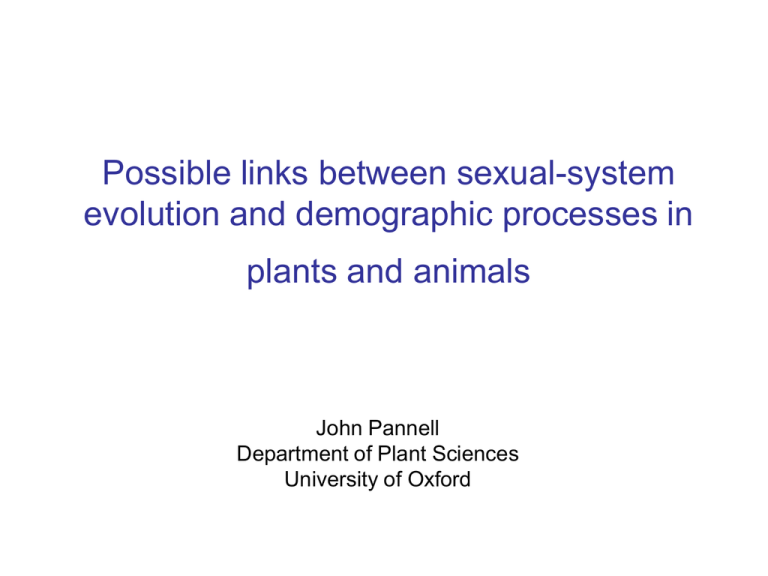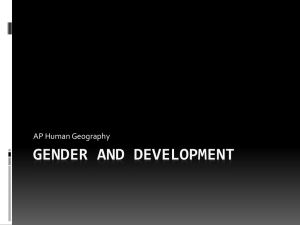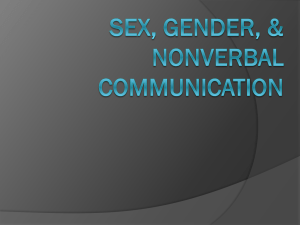
Possible links between sexual-system
evolution and demographic processes in
plants and animals
John Pannell
Department of Plant Sciences
University of Oxford
(Male-sterility)
Gynodioecy
Hermaphroditism
Androdioecy
(Female-sterility)
Frequency of males or females
Maintaining males versus females
0.5
0.4
0.3
0.2
0.1
0
0
2
4
6
8
Relative production of seeds or pollen
(relative to hermaphrodites)
10
Frequency of males or females
Maintaining males versus females
Gynodioecy
under selfing &
inbreeding depression
0.5
0.4
0.3
0.2
0.1
0
0
2
4
6
8
Relative production of seeds or pollen
(relative to hermaphrodites)
10
Frequency of males or females
Maintaining males versus females
Gynodioecy
under selfing &
inbreeding depression
0.5
0.4
0.3
Androdioecy
under selfing &
inbreeding depression
0.2
0.1
0
0
2
4
6
8
Relative production of seeds or pollen
(relative to hermaphrodites)
10
Predictions
1. Androdioecy should be difficult to evolve
2. Androdioecy should occur only where
hermaphrodites are prevented from selfing
In fact…
1. Androdioecy has evolved several times
2. Males typically occur with partially selfing
hermaphrodites
Occurrence of androdioecy
Mercurialis annua
Kryptolebias marmoratus
Datisca glomerata
Schizopepon bryoniaefolius
Several species of branchiopod
crustaceans
Herm
Sassaman, 1995
Male
Steve Weeks
Several species of the Oleaceae
Wallander, 2001
Mercurialis annua
Durand (1963)
population growth
reduced selfing
Colonisation
hermaphrodites selected
with female-biased sex
allocation
Established
population
males
hermaphrodites
Immigration
males selected
Within-population diversity
Males present
0.43
Males absent
0.11
Pair-wise differentiation
Hermaprodite populations
Populations with males
3
F'ST/(1-F'ST)
P < 0.001
2
1
0
0.0
0.5
1.0
1.5
log(Geographic distance)
Obbard, Harris & Pannell (Am Nat, 2006)
2.0
2.5
Males present
Males absent
• 445 populations
• 5 transitions in
breeding
system
• 3 years of
demographic
sampling
Males + females
Hermaphrodites
Dorken & Pannell (2007: Heredity)
Abundance (number of plants)
7000
Males present
6000
5000
4000
3000
Males absent
2000
1000
0
40
50
60
70
80
90
100
Occupancy (% occupied sites)
Eppley & Pannell (2006: American Naturalist)
49/185
25/171
Males present
Males absent
Dorken, Freckleton & Pannell (unpublished data)
Dioecious
Monoecious
Androdioecious
0.7
Androdioecious
Monoecious
0.6
0.5
0.4
H'S
Dioecy
(Central)
Dioecy
(West)
0.3
0.2
Dioecy
(East)
0.1
6x
0.0
Monoecy
-0.1
32
34
36
38
40
42
44
Latitude
1.8
2x
1.7
Allelic Richness
1.6
1.5
1.4
1.3
1.2
1.1
Obbard, Harris & Pannell
(American Naturalist, 2006)
1.0
-10
0
10
Longitude
20
30
Dioecious
Monoecious
Androdioecious
0.7
Androdioecious
Monoecious
0.6
0.5
Dioecy
(West)
H'S
0.4
Dioecy
(Central)
0.3
0.2
Dioecy
(East)
0.1
6x
0.0
Monoecy
-0.1
32
34
36
38
40
42
44
Latitude
Is there less inbreeding
depression in northern
populations of M. annua?
wout wself
wout
Pujol et al. (PNAS, 2009)
Dioecious
Monoecious
Androdioecious
0.7
Androdioecious
Monoecious
0.6
0.5
Dioecy
(West)
H'S
0.4
Dioecy
(Central)
0.3
0.2
Dioecy
(East)
0.1
6x
0.0
Monoecy
-0.1
32
34
36
38
40
42
44
Latitude
Is there less quantitative
genetic variation for sex
allocation in northern
populations of M. annua?
Pujol and Pannell (2008, Science)
hermaphrodites
hermaphrodites
Frequency
males
0.0
Sex allocation
1.0
Male
frequency
Nutrient
status
HIGH
6 Replicates
LOW
6 Replicates
HIGH
HIGH
6 Replicates
LOW
6 Replicates
LOW
Dorken and Pannell (Current Biology, in press)
Durand (1963)
Selfing rates in different patches
monoecious patch
androdioecious patch
0.50
0.45
0.40
selfing rate
0.35
0.30
0.25
0.20
0.15
0.10
0.05
0.00
1
2
3
4
5
6
7
8
9
10
11
12
13
14
15
Without males
With males
population
Korbecka and Pannell, unpubl.
Dorken, Freckleton & Pannell
(unpublished data)
Eppley and Pannell (2008: Evolution)
Occurrence of males with hermaphrodites
Eulimnadia texana
Datisca glomerata
Schizopepon bryoniaefolius
Herm
Male
Kryptolebias marmoratus
Caenorhabditis elegans
Herm
Males and hermaphrodites in
Eulimnadia species
Male
Hermaphrodites
Weeks et al. (2006)
Males + hermaphrodites
24–180 million years ago
Males + females
Why is androdioecy in
Eulimnadia so ancient?
Hermaphrodites are the
heterogametic sex
W/Z
Z/Z
W/Z
Z/Z
Deleterious recessives on W
• NOT expressed
• FIXED by drift
Selection for reproductive assurance
• Females produce an ovotestis
• Androdioecy evolves
W/Z
Z/Z
Selfing produces homozygous W
• Load on W now expressed
• Fitness of W/W < W/Z
W/Z
W/W
Maintenance of males
0.6
0.9
==0.9
0.5
=0
(no recessive load on W)
0.4
= 0.1
Male frequency
0.3
0.2
0.1
0
0
0.6
0.2
0.4
0.6
0.8
1
= 0.9
0.5
= 0.5
>0
(recessive load on W)
0.4
0.3
0.2
= 0.1 (recessive load on W)
0.1
0
0
0.2
0.4
0.6
0.8
1
Probability of finding a mate
Maintenance of males
0.6
0.9
==0.9
0.5
=0
(no recessive load on W)
0.4
= 0.1
Male frequency
0.3
0.2
0.1
0
0
0.6
0.2
0.4
0.6
0.8
1
= 0.9
0.5
= 0.5
>0
(recessive load on W)
0.4
0.3
0.2
= 0.1
0.1
0
0
0.2
0.4
0.6
0.8
1
Probability of finding a mate
Pannell (2008: Genetical Research)
Males maintained by overdominance?
• ZZ males: low fitness
– can’t find a mate
• WW hermaphrodites: low fitness
– reproductive assurance
– BUT recessive genetic load on W chromosome
• WZ hermaphrodites: high fitness
– reproductive assurance
– AND sheltering of genetic load on W chromosome
Fraxinus ornus
• Oleaceae family
• Dioecy & androdioecy
are frequent in genus
and family
Verdu, Montilla & Pannell (Proc. Royal Soc., B, 2004)
First puzzle…
• Males and hermaphrodites co-occur
Implies androdioecy
• 1:1 sex ratio
Implies cryptic dioecy
• Hermaphrodites do sire seeds
Implies androdioecy
Functional Ecology (2002): 16: 858-869
Fraxinus
ornus
Proc. Royal
Soc., B (2004):
271: 2017-2023
Evolution (2006)
father
mother
father
mother
Male-sired seedlings grow 8% faster than
hermaphrodite-sired seedlings
Proc. Royal Soc., B (2004): 271: 2017-2023
Hermaphrodites can be
fathers but not grandfathers
Hermaphrodites are
functionally female
Fraxinus
ornus271: 2017-2023
Proc. Royal
Soc., B (2004):
Evolution (2006)
Second puzzle…
• Females produce lots of pollen… Why?
M
F
F
M
Intense competition in the seed shadow
Fraxinus ornus
Second puzzle…
• Females produce lots of pollen… Why?
M
F
F
Rival’s seedlings
are less competitive
M
ESS: all females invest
up to 50% of reproductive
resources in pollen
Intense competition in the seed shadow
Fraxinus ornus
Pannell (unpubl.)
Third puzzle…
• What is the mechanism of sabotage?
Thanks to…
•
•
•
•
•
•
•
•
•
Darren Obbard
Richard Buggs
Stephen Harris
Sarah Eppley
Marcel Dorken
Paul Rymer
Rob Freckleton
Grazyna Korbecka
Stephen Weeks
• … and many undergraduate assistants
NERC
Royal Society
BBSRC
European Union









